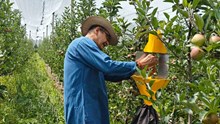
Makhana, also known as fox nuts or Euryale ferox, is a highly valuable crop that offers both profitability and sustainability for farmers. Thriving in water bodies such as ponds and marshes, makhana has become an essential agricultural product, particularly in regions with abundant water resources. Bihar stands out as the leading producer, contributing over 80% of India's total makhana yield. The crop is gaining popularity in other states as well, with Bihar receiving a Geographical Indication (GI) tag for its renowned Mithila Makhana. For farmers interested in cultivating this lucrative crop, understanding the right cultivation techniques and management practices is crucial for ensuring a successful harvest.
Climatic and Soil Requirements
Makhana grows best in tropical and subtropical climates. This crop grows best in temperatures between 20°C and 35°C. It needs bodies of water that are motionless or move slowly and are between one and two meters deep. Clayey or loamy soil with a high organic matter content is desirable.
To guarantee healthy growth, farmers should remove weeds and other undesirable vegetation from the water body before planting. For plants to develop, they must also receive enough sunlight. Partial shade can sometimes increase productivity since shade is also significant.
Planting and Cultivation Process
Seed selection is the first step in makhana cultivation. Quality seeds should be selected for better yield. Seeds are sown in water bodies during April and May. The seeds germinate initially in shallow water then they are transferred to deeper areas as the plants grow. The water level must be maintained at an optimal level throughout the growing season by the farmers.
Pests and diseases need to be controlled by regular monitoring. Organic farming practice enhances soil fertility using cow dung manure and bio-fertilizers. Regular de-weeding prevents competition for nutrients required by crops. Good aeration of water and normal removal of unwanted aquatic plants ensure the purity of water. The purity of water helps to the growth of healthy crops. The crop reaches maturity within 180-200 days after the maturation point the harvesting process starts.
Harvesting and Post-Harvest Processing
Makhana is harvested by hand by expert laborers. The seeds are pulled out of the water and dried in sunlight. They are roasted after drying in a clay pan. It popped like popcorn to yield the edible makhana. Popping of makhana is done by carefully controlling temperature to ensure proper expansion of seeds. The popped makhana is then cleaned, graded, and packed to be sold in the market.
Makhana should be stored after processing in dry conditions to avoid absorbing moisture. The moisture can cause it to spoil Makhana. Proper storage in airtight containers or vacuum-sealed packs can help keep it fresh and extend shelf life.
Market Opportunities and Benefits
Makhana is gaining popularity due to its nutritional value and health benefits. It contains protein, fiber, and antioxidants. It became popular as a healthy snack due to its numerous health benefits for health-conscious consumers. It is also low in cholesterol and fat which makes it ideal for people who are on a diet. As more and more people are becoming aware of its health benefits, the demand for makhana is increasing in both domestic and international markets.
Farmers can sell the produce in local markets, and wholesale markets. The online market is the new hype so even they can explore online platforms for better profits. Value addition can be done in this crop like flavored makhana or makhana-based products like energy bars and sweets. These value additions can further enhance market potential. The government also provides support and subsidies for makhana cultivation to farmers. These support and subsidies encourage more farmers to adopt this profitable venture.
Makhana farming presents a profitable opportunity for farmers willing to invest time and effort, especially through organic practices. By managing water levels and using proper techniques, farmers can yield high returns. As demand grows due to health consciousness, Makhana farming could become a major agricultural business in India. Expanding processing facilities and improving market connections can boost its sustainability and profitability.
















